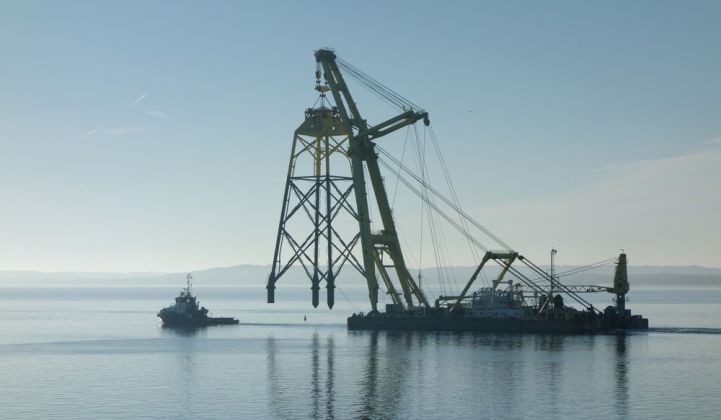European offshore wind developers could go one step beyond zero-subsidy projects and start paying a tariff for contracts.
So-called negative bids are “quite likely” in forthcoming European offshore wind tenders, said Michael Dodd, U.K. and Ireland director at consultancy DNV GL. Such bids would come in markets that have already seen zero-subsidy projects, Dodd added.
Although subsidy-free projects are becoming increasingly common in onshore wind and solar across Europe, so far only a couple of offshore markets have reached that point explicitly.
The Dutch first?
But going forward, said Dodd, developers seeking large pipelines might be tempted to pay for a lease in a low-risk market such as Holland so they can make up for any projects that fail to go ahead in more difficult environments. “It’s them buying the option,” Dodd said.
Based on events so far, the Dutch market appears to be the most likely candidate for the emergence of negative bidding, he said.
“We saw some aggressive strategies in the previous round in the Netherlands,” said Dodd. “The types of players that were playing in that auction are looking for ways they can reduce even further. If you go beyond zero, there’s only one way you can go. The Netherlands is probably where you may see it first.”
Europe's first no-subsidy offshore wind project emerged in 2017 in Germany, when utility EnBW and Dong Energy (now Ørsted) opted to go without subsidies for plants due to come online by 2025. The developers effectively bet on continued reductions in wind's levelized cost of energy, while taking advantage of the German government's willingness to cover grid-connection costs.
The grid-connection issue was also key when Holland tendered its Hollandse Kust Zuid 1 and 2 sites in 2017. Competing in a packed field, the Swedish developer Vattenfall concluded that not having to pay for a grid link could allow it to dispense with subsidies for offshore wind power from 2022 onward. The company walked away with 750 megawatts of capacity.
German lawmakers banned negative bidding in the country’s April 2018 offshore wind solicitation, which was for 1.6 gigawatts of capacity. This was mainly to discourage unrealistic offers from large firms looking to cut out smaller rivals.
Dutch policymakers had no such qualms in their second Hollandse Kust Zuid tender in 2018. They stipulated there would be no government support for the 760 megawatts on offer across the Hollandse Kust Zuid 3 and 4 lease sites, leading to intense speculation over the prospect of negative bids.
In the end, developers including Vattenfall, Engie, Ørsted and Eneco (in a consortium with Shell and Van Oord) shied away from negative bidding. Vattenfall again won the contest, giving it more than 1.5 gigawatts of unsubsidized offshore wind capacity in Holland.
Germany and the Netherlands remain atypical markets, experts point out. The governments' willingness to cover grid connection costs and to avoid imposing other significant duties on project developers equates to little downside if a developer ultimately is unable to complete a no-subsidy project.
But Andrei Utkin, senior analyst for global power and renewables at IHS Markit, said Europe effectively has already seen negative bids in other markets once future wholesale prices are factored in.
“In a way, when we compare the French and U.K. winning bid levels with forward prices, we already see negative bids: forward baseload prices for year-ahead delivery are above those levels," Utkin said.
More and more renewables coming onto the grid will result in more curtailment and lower wholesale power prices, he said. “As a result, the price that renewables will be able to capture in the market will decrease as well, going below their levelized cost of energy and potentially triggering the need for government support.”
What comes next
According to the Netherlands Enterprise Agency, a permit for the development of 700 megawatts in the Hollandse Kust Noord wind farm zone site will be tendered in the fourth quarter of this year.
And if that fails to draw negative bids, Germany’s offshore wind industry bodies have called on Berlin to tender up to 2 gigawatts of capacity this year. Both countries also have ambitious build-out plans going forward.
Holland will be tendering 1.4 gigawatts of capacity in 2021 and 700 megawatts in 2022; Germany intends to offer 5 gigawatts in 2023.
Despite the risks, ambitious developers may increasingly see it as worth putting some money on the table to secure a big slice of those pies.
***
Are you attending WindEurope Offshore in Denmark? Join Wood Mackenzie for an invite-only analyst briefing and breakfast on November 27th. Learn more and register your interest here.




